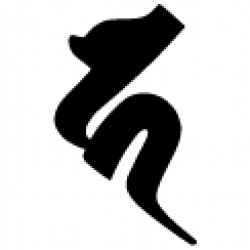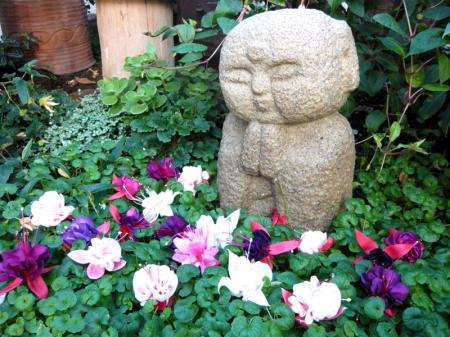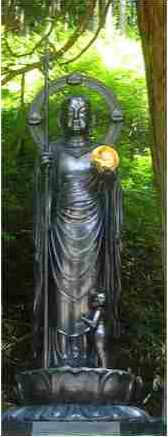Jizo Bosatsu

In Buddhism, especially esoteric Buddhism, many beings who attained
or renounced to Buddhahood are here to show us the way to Nirvana. Some
of them, like Jizo Bosatsu, made two vows. One, to take responsibility
for the instruction of all beings in the six worlds between the death
of Shakyamuni Buddha (the historical Buddha) and the rise of Miroku
Bosatsu (Buddha of the future).The other, not to achieve Buddhahood
until all hells are emptied.
 |
Description
O-Jizo-Sama as he is often respectfully called, is one of the most
venerated Bosatsu in all of Japan. He is usually depicted as a monk,
wearing robes with a shaven head. He often holds a staff called a
shakujo. This is used to both scare away living creatures so he doesn’t
hurt them accidentally, and to awaken us from our dream-like world of
illusion. On many images and statues, he holds a wish-granting jewel
that he shares with Kanzeon Bosatsu and Vishnu in the Hindu tradition.
You can find O-Jizo-san (Ksitigarbha in Sanskrit) in cemeteries,
gardens, on road-sides and of course temples all over Japan. He is the
protector of travelers, children and all beings trapped in hell.
 |
You can see Jizo with the Shakujo and the Wish-granting Jewel here. |
The story goes, that the souls of children who die before their
parents, are not capable of crossing the fabled Sanzu River (similar to
the Styx river in Greek mythology) in the afterlife. This is because
they have not had the time to accumulate enough good deeds (karma) and
they have made their parents suffer. It is believed that Jizo saves
these souls from the punishment of having to pile stones eternally on
the bank of the river. O-Jizo-sama, is thus widely recognize as the
saint patron of dead children, especially still-born and aborted
children.
|
You often encounter Ojizo-sama in graveyards and it is not unusual
to see the idol adorned with a red bib and a red baby hat. The reason
for this, is parents put it there to either thank him for saving a
child from illness or to ask him to protect a child in the after-life.
Thus each time you see a Jizo statue, adorned with these clothes, you
witness the pain of a parent. Sometimes, you’ll see small piles of
stones next to the statues and those are connected to building stupas
for the granting of merit. Doing so, the parents hope to earn enough
merit for their child so that it can cross the river as fast as
possible and thus, end suffering.
If you go to Koya-san’s graveyard, there is a river crossing it. The
river from that river is sacred and brings comfort to the souls. That
is why people splash the statues of Jizo with it as you can see in the
following video.
Iconography
As I described before O-jizo-sama is usually depicted with a shaven
head, and dressed in a monk’s simple robes. In his left hand, he
carries a wish-granting jewel and in his right hand, he holds a shakujo
(錫杖). Ojizo-sama will sometimes be seen wearing a crown depicting the Five Great Buddhas, worn by Tibetan and Chinese monks in Tantric rituals.
Like other Bodhisattvas, Jizo Bosatsu, when depicted standing, is
upon a lotus base, symbolizing his release from the karmic wheel of
rebirth. Jizo’s face and head are also idealized, featuring the third
eye, elongated ears and the other standard attributes of an enlightened
being. In many cases, you will see him surrounded by children, playing
on his body or hiding from demons in his robes.
You can see more pictures of Jizo in my Buddhism pictures gallery.
Mantra
おん かかか びさんまえい そわか
The main mantra of Jizo Bosatsu is:
On kakaka bisanmaei sowaka; (in Japanese.)
Om ha-ha-ha vismaye svaha; (in Sanscrit.)
Om Oh, Wondrous One svaha; (in English).
My personal experience
I have always admired O-Jizo-sama imagery as it is a really popular
icon in Japan. You cannot walk for 15 minutes, even in the heart of
Tokyo and not encounter an image, a statue, or a doll depicting
Ojizo-sama. It is that important to Japanese people. It goes, without a
doubt, hand in hand with the importance of children as he is their
protector. Thus, it is very sad to go to a cemetery and see all these
statues of the venerated Bosatsu. Each carries a sad story.
|
Return from Jizo Bosastu to Buddhist Pantheon |


New! Comments
Have your say about what you just read! Leave me a comment in the box below.